We explored ways to help higher education institutions (HEIs) register to use Manage and invite their school direct partners (SDs) to register.
Why we are doing this
Around 70 HEIs have not yet registered to use Manage. On average each of them accredits courses for 10 SDs, many of which are also not registered on Manage. We do not have contact details for all the SDs.
We need to make sure that all these organisations have registered to use Manage before the UCAS service is turned off in October 2021.
Adding them all manually will be a lot of work for the transition team. We want to make the process more efficient, without adding a significant burden on users at HEIs or SDs.
Requirements
Before we started designing possible solutions, we spoke to members of the provendor and transition teams about their requirements.
These requirements are not presented as user needs, since this work is being done primarily for the benefit of teams within DfE.
Data sharing agreement
We need to:
- make sure that HEIs and SDs sign a data sharing agreement (DSA)
- record who signed the DSA
- only show personal data to HEIs and SDs after they’ve sign the DSA, so we do not violate data protection rules
Getting contact details
We need to make sure we have an up to date contact name and email address for each SD.
Inviting training providers
We need to:
- reduce the amount of manual work done by the transition team, to save team effort and reduce the risk of errors
- know which HEIs are on Manage
- know which SDs have been set up for each HEI
- know which SDs have set up and opened courses on Manage
Provider data analysis
There are 87 HEIs in the Manage database. 22 HEIs have been set up to use Manage and the remaining 65 have not.
Number of SDs connected to each HEI
Using the Publish database, we looked at how many SDs are connected to each HEI.
- 25% of HEIs have no SDs
- 24% of HEIs have between 1 and 10 SDs
- 36% of HEIs have between 11 and 20 SDs
- 15% of HEIs have more than 20 SDs
- Average number of SDs per HEI: 10
- Maximum number of SDs per HEI: 33
- Minimum number of SDs per HEI: 0
If we ask an HEI user separately about each SD then on average they will see 10 pages of questions.
Number of HEIs connected to each SD
- 77% of SDs have only 1 HEI
- 14% have 2 HEIs
- 6% have 3 HEIs
- 3% have more than 3 HEIs
This is important because if an SD has multiple HEIs, they only need to be registered once. The other HEIs ratifying their courses will not need to provide contact details for them.
Cross-over between users of Manage and Publish
Manage users in publish
- 59% of Manage users are in Publish
- 68% of active Manage users are in Publish
- 63% of active Manage users are active in Publish
Publish users in Manage
- 20% of Publish users are also in Manage
- 27% of active Publish users are in Manage
- 23% of active Publish users are active in Manage
As there are a lot of Publish users who are not on Manage, we can use their information to ease the registration process as they’ll already have DfE Sign-in accounts.
Iteration 1
We decided to start by prototyping a separate flow that would allow HEI users to provide us with the information we need.
What we did and why
In our first iteration, we wanted HEI users to answer two questions.
- Do you want to open courses at the training provider?
- Who do you want to manage teacher training applications at the provider?
This would allow us to invite the right people at each SD, while leaving the HEI in control of when their courses become available.

The journey began on a ‘start page’ listing the SDs working with the HEI and setting out the steps involved in creating an account.
The aim was to give the user a chance to gather information before starting, which is important since it is not possible to save and return to the process.
Users would reach the start page from an email. For this iteration we did not include DfE Sign-in account creation, as we assumed that the email would contain a ‘magic link’ bypassing it.
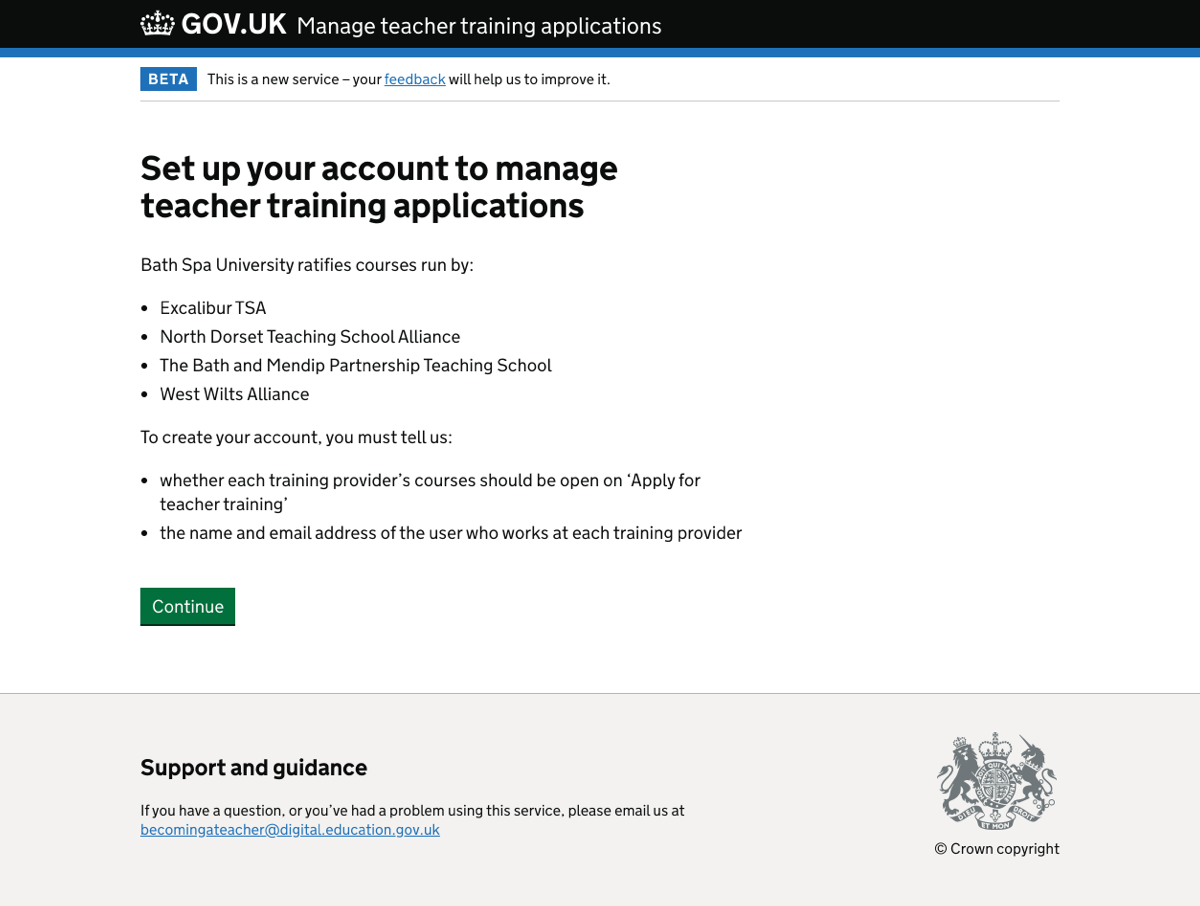
In this iteration we assumed that HEIs may not want to open courses on Find during this process.
After the start page, the user was asked whether they would like to open courses at each SD. For this iteration we set this out as one SD per page.
If the user said they would like to open courses then they were asked for contact details. No fields were pre-filled as we assumed we wanted to gather fresh information.

Once the user had decided whether or not to open courses for each SD, they were asked to complete a data sharing agreement (DSA).
We took the existing DSA directly from Manage without any changes. Our main concern was not readability, but whether users felt they could sign it or would need to refer to someone else.
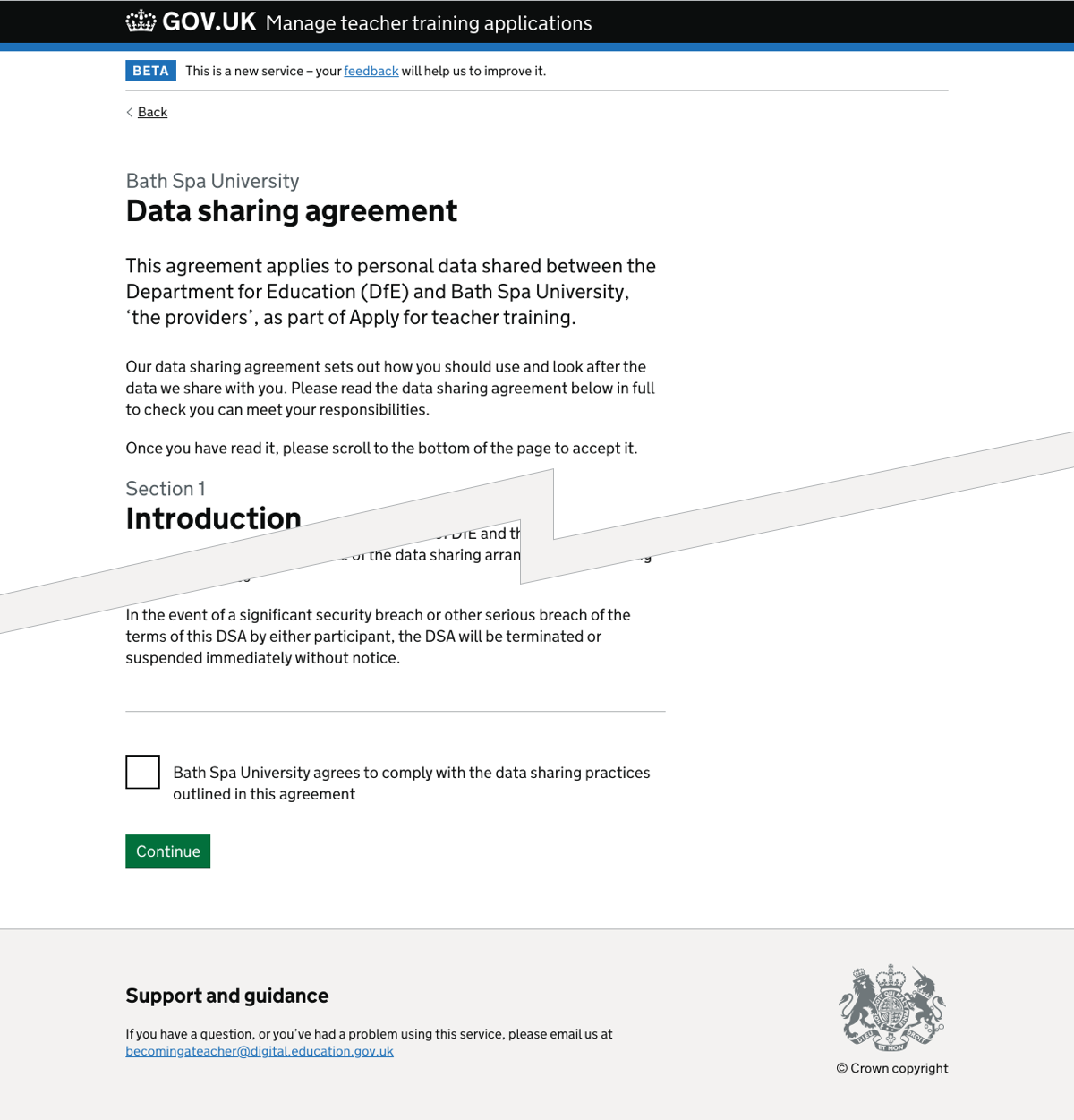
On the ‘check answers’ page we needed to make it clear that clicking ‘send invites’ would send invitations to SDs. We also decided to remind the user that they would be agreeing to the DSA.

We used a standard success page and did not tailor it to this journey at all. This was largely due to a lack of time, but also because we did not know what the next steps would be.

Iteration 2: using the task list pattern
For this version, we explored using the task list pattern to allow a non-linear journey. Users could use the task list to choose the order in which to provide contact details.

The task list page gave two tasks for each SD:
- decide whether to make courses available
- decide who to invite
The user could only complete the second task once the first had been completed.
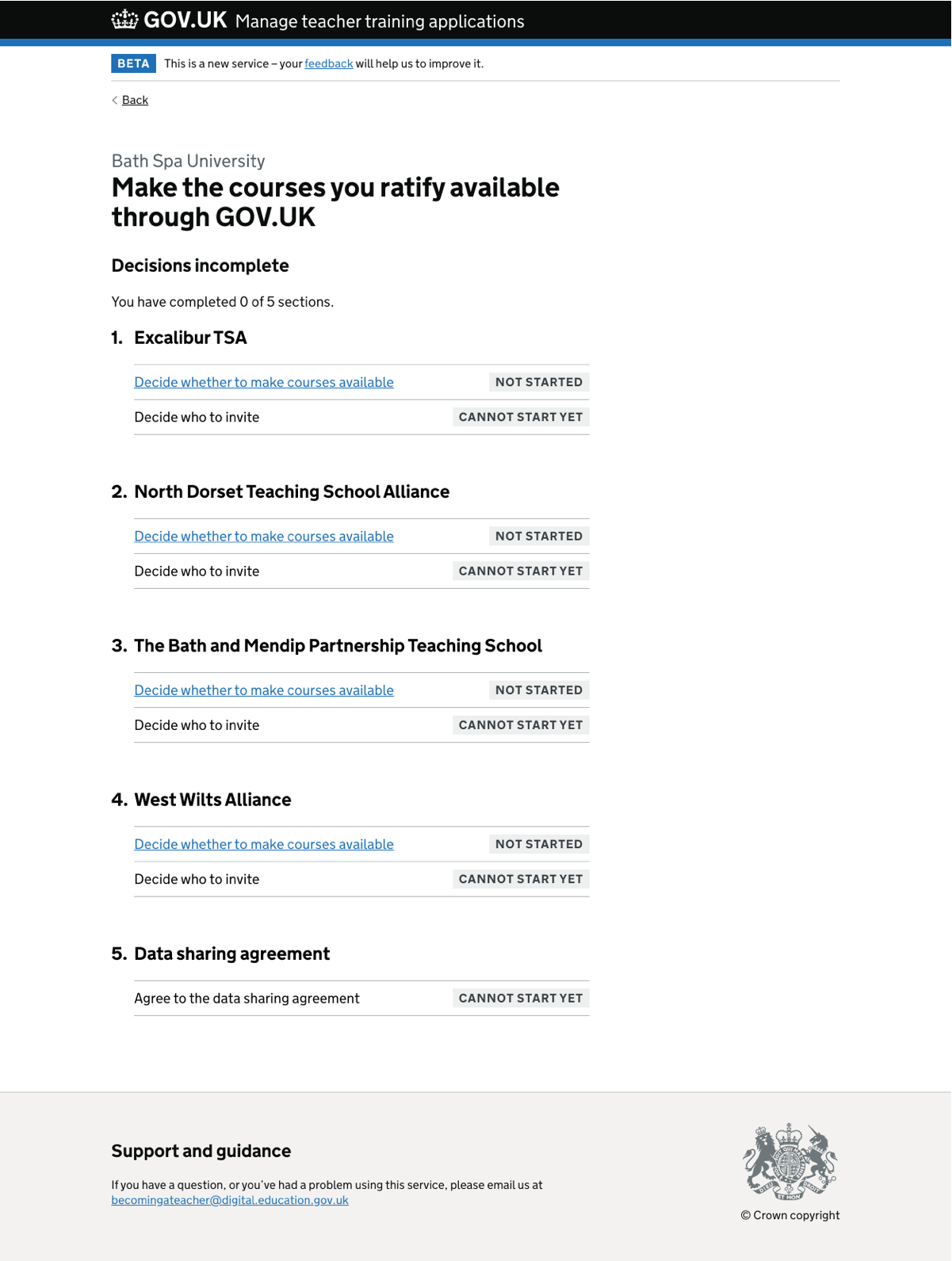
We did not use the task list pattern as we decided it would only be of value if we allowed the ability to save and return later. Without allowing this, the user would still need to gather the contact details in advance whether they had to enter them in a fixed sequence or in an order of their own choosing.
Iteration 3: assuming courses will be opened
In this iteration we assumed that all courses would automatically be opened once the relevant HEI and SD were registered on Manage.
We removed the ‘Do you want to open courses at the training provider?’ question and went straight to asking for contact details.
What we did and why

The start page listed the SDs we needed contact details for. We only asked about SDs which are not already using Manage, reducing the effort required by the HEIs to complete the process.
We also listed the SDs which are already using Manage, so that the user would not think we’d missed them out.

For each of the SDs which were not on Manage, we included a list of people who already had accounts in the Publish service. This was intended to further reduce the effort needed to complete the form.
Users could either choose one of these people or add new contact details.
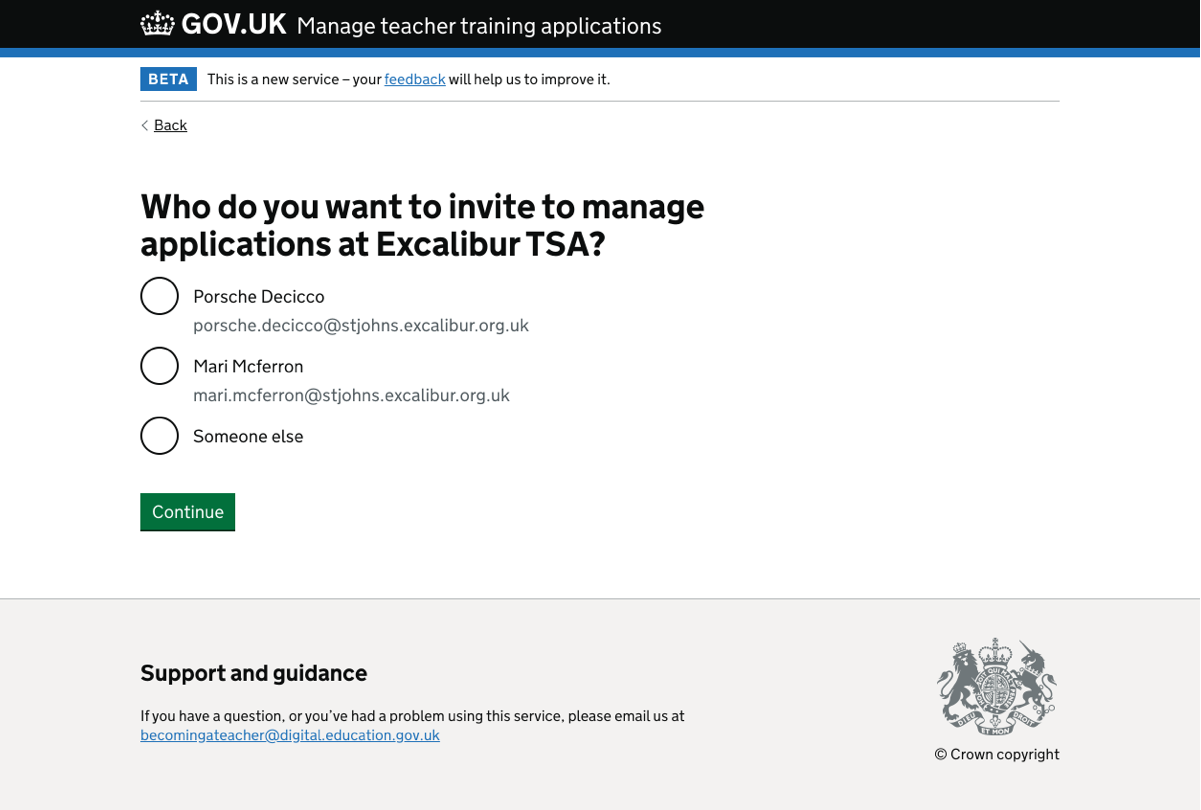


The data sharing agreement remained the same as in Manage.

We removed mention of the DSA from the ‘check answers’ page since there was already a confirmation check box at the end of the DSA itself.
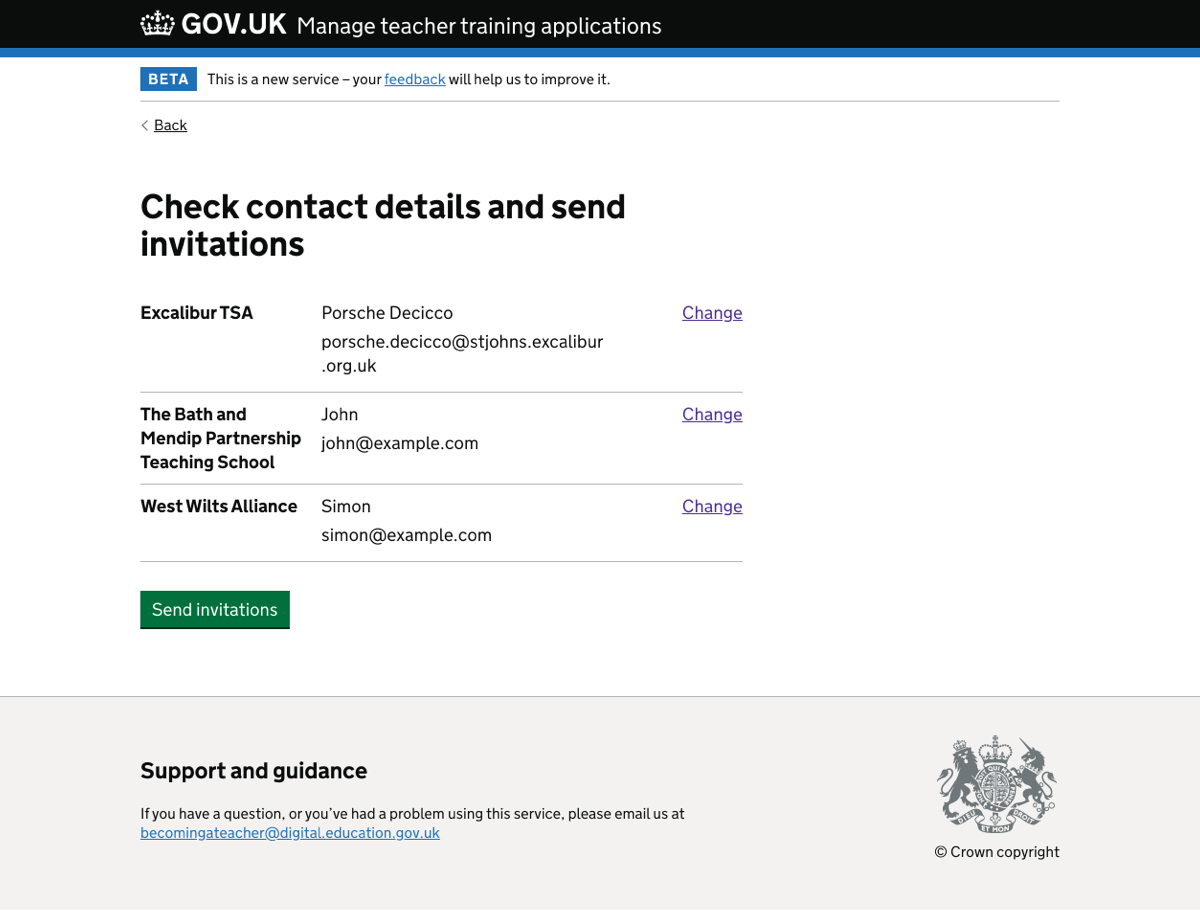
The success page had minimal content, saying that:
- invitations had been sent to SDs
- courses would be made available once the SDs set up accounts
- the user would receive an email telling them how to finish setting up their account
We were still assuming that the user would have entered this service through a ‘magic link’ and so would have to do further things to finish setting up their account.
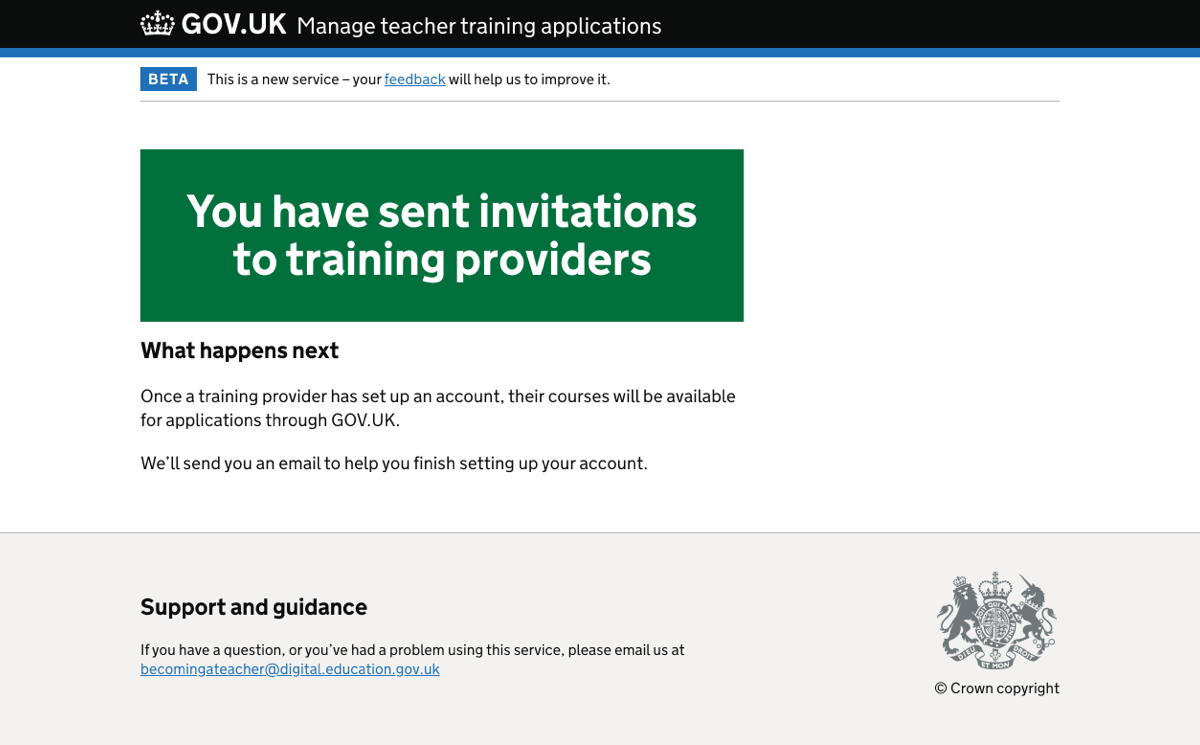
What we learned
General
- Some users expected permissions to be handled as part of this process.
- Users may be able to complete the task in a single session, but they’d need to gather contact details first (possibly from colleagues).
- Some HEIs would like an overview of the SD journey. They would like to speak to their SDs before providing their details to DfE.
- It was hard for users to understand the instructions in the email without context. One participant thought that they needed to send the link to their SDs.
- We’d need to work closely with the transition team to make sure that HEIs get appropriate contextual information before receiving the email.
- It’s important to be clear about what’s going to happen after the HEIs have provided details of SDs.
Start page
- Users weren’t sure where the list of schools came from, but this wouldn’t prevent them from completing the task.
Data sharing agreement
- Users asked why they were being asked to sign a DSA after they’d already provided some data.
- The user may not have the authority to sign the DSA, so there’s an argument about handling it outside of this process.
Contact details
- Users weren’t sure where the email details came from, although this wasn’t helped by the use of test data rather than email addresses they recognised.
End of process
- HEIs would like to be notified once an SD completes their registration on Manage.
Iteration 4: reorganising the flow and including DfE Sign-in
For this iteration we reordered the questions so that DfE Sign-in and the DSA came before asking who to invite from each training provider.
We decided that we would not be able to use a ‘magic link’ as they only work for a short time. It would be better to use DfE Sign-in and get users to set up accounts in the usual way.

The start page set out the steps of the journey:
- either sign in or register with DfE Sign-in
- accept the DSA
- provide contact details for SDs
It also listed the SDs which required contact details and those which did not.
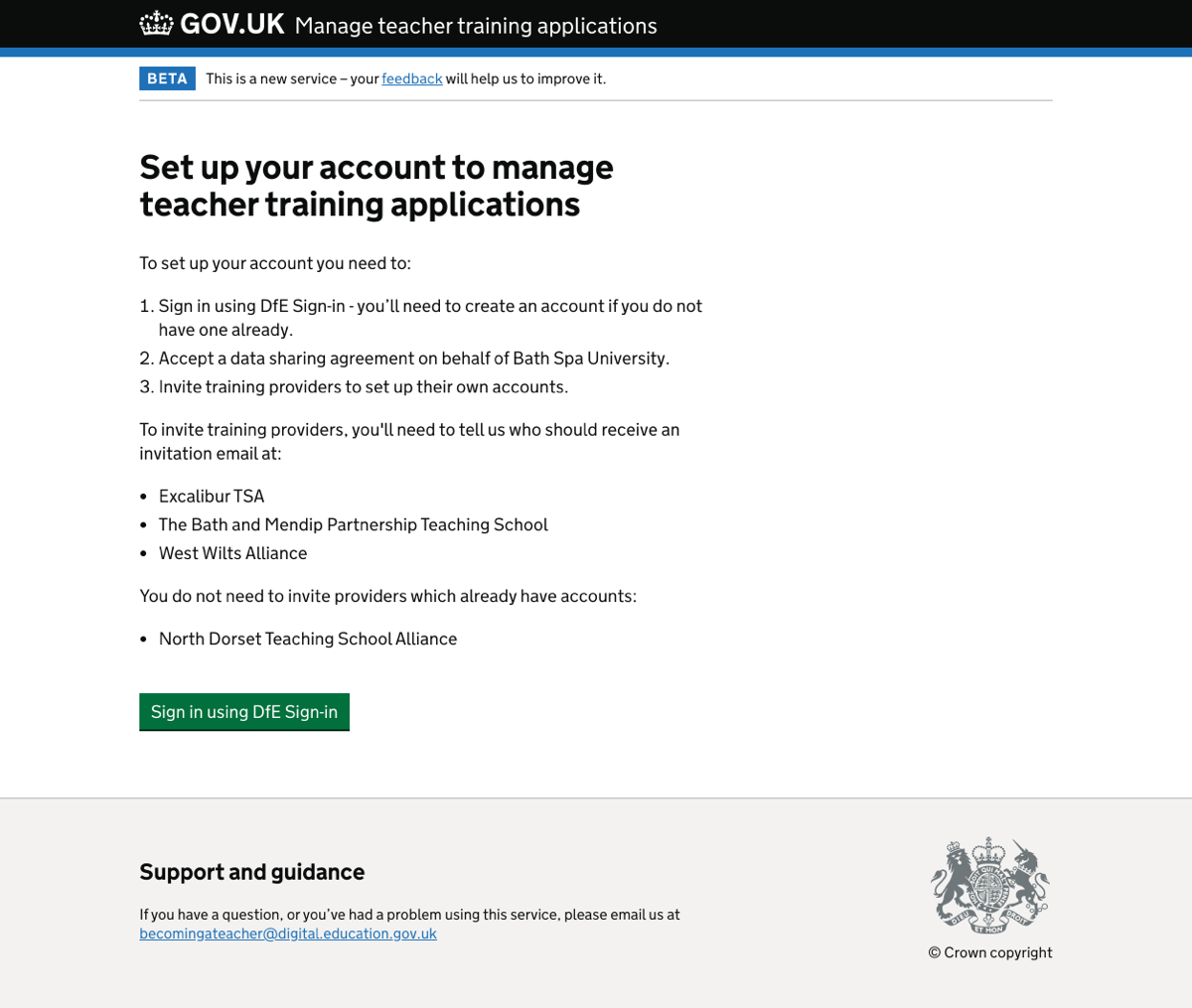
We mocked up the DfE Sign-in flow to make the overall journey more realistic.

The DSA remained the same as in previous iterations.
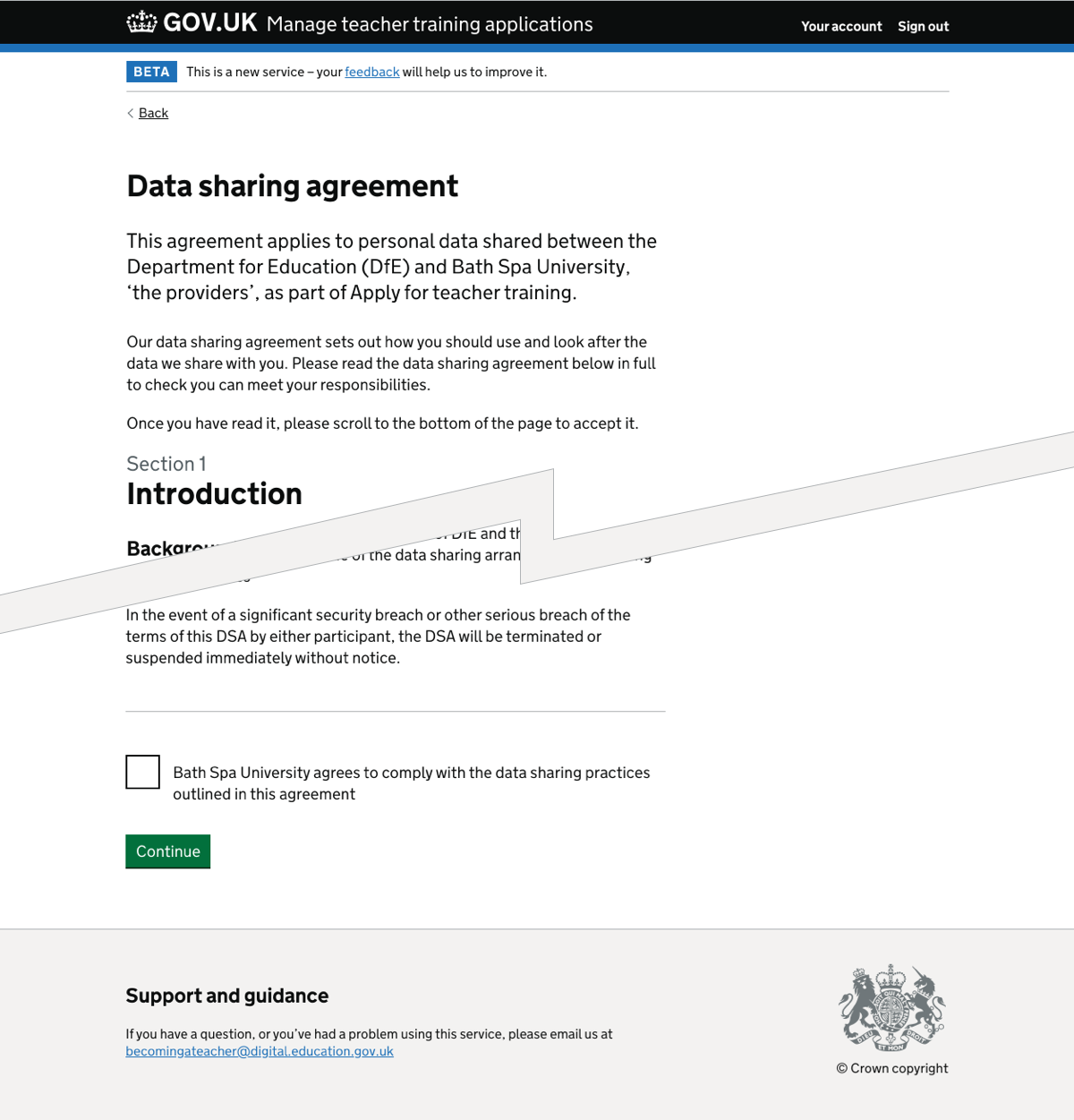
We included a mid-journey ‘start page’ after DfE Sign-in and the DSA, in case the user had forgotten the details of what they would need to do.

The invitation, check answers and success pages were the same as in previous iterations.

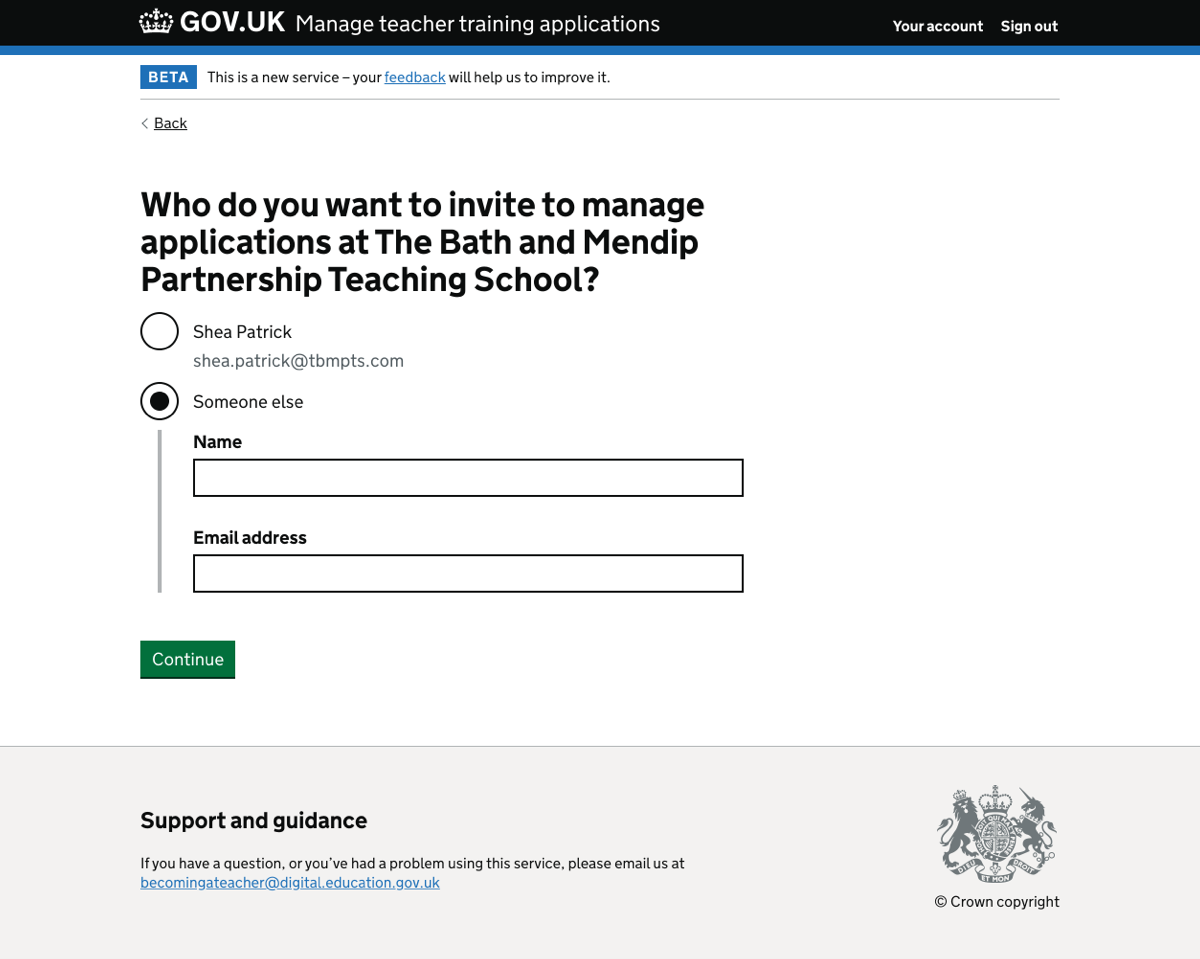


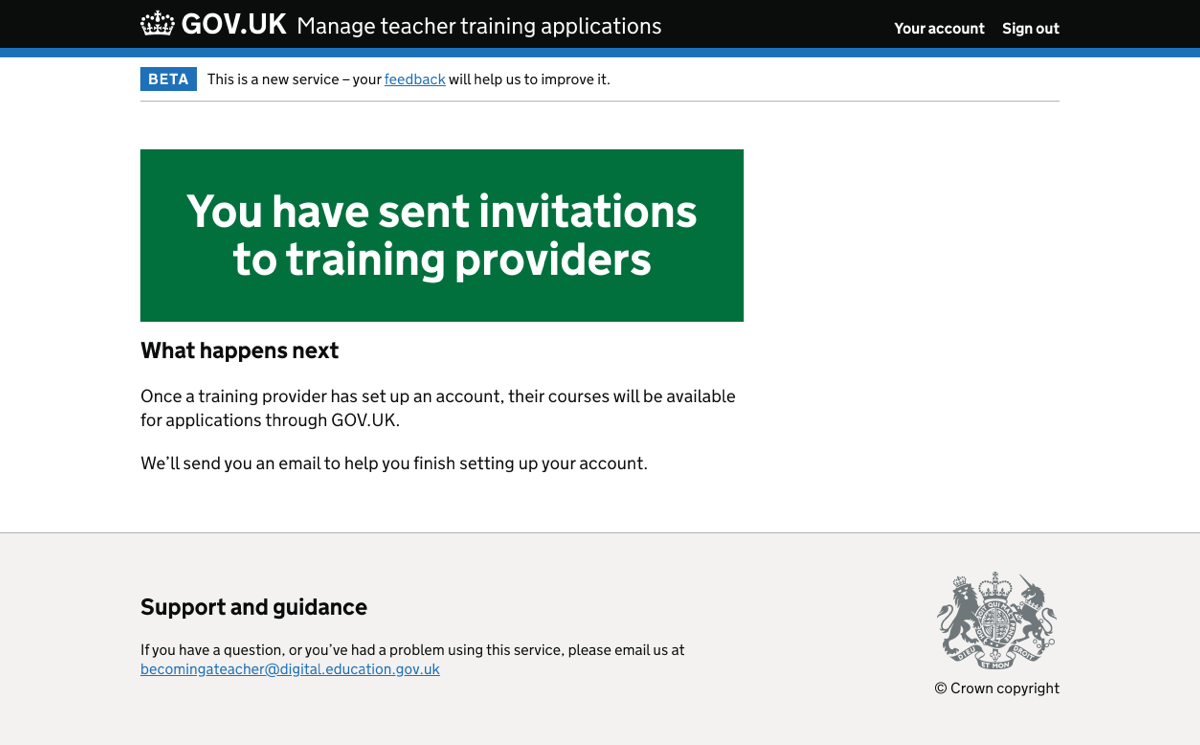
Next steps
After analysing the research findings from iteration 3, we decided not to continue designing a service for HEI users to invite their SD partners.
We made this decision because we found that:
- some users would find it hard to complete the process in a single session
- the user giving contact details might not be able to agree to the DSA
- it was hard to give users enough information for them to complete the process
We decided to try a simpler approach, gathering contact details in a spreadsheet and setting up SDs in manage using the support console.